Content
Flowers similar to petunias are popular among gardeners for their attractive appearance and variety of uses. Such plants are not only planted in flower beds, but also placed in pots, flowerpots and hanging containers. Despite the fact that the shape or color of these flowers is similar to petunia, they can differ significantly in other characteristics.
What flowers look like petunia
Petunia is a very unpretentious culture that can be widely used in landscape design and decoration of the local area. This plant is actively used to decorate open terraces, verandas and galleries. A wide palette of natural shades and unpretentiousness make this culture very popular among gardeners.
Photos with the names of flowers similar to petunia, as well as their main features, can be seen below.
Calibrachoa
Calibrachoa is an ampelous culture that looks very much like a petunia. The flowers of the plant are smaller in size (1-3 cm) and in large numbers cover strong branchy stems with a small "pile". Under favorable conditions, they grow in length up to 1-1.5 m.

Calibrachoa does not tolerate direct sunlight
The range of shades is very large. But most of the calibrachoa can be seen in brown, purple and yellow. The culture is planted in slightly shaded places, since the plant does not accept the sun and does not tolerate drafts. Calibrachoa is propagated most often by cuttings or seeds. Watering loves in moderation. The main agricultural technology of the variety is very simple.
Minitunia
Another culture of the ampelous type with flowers similar to petunia, only smaller. Minitunia is one of the related hybrids, which has a similar agricultural technique and such an important property as ease of care. The main difference between the culture is strong branching, accompanied by abundant budding and the formation of a large number of small flowers.
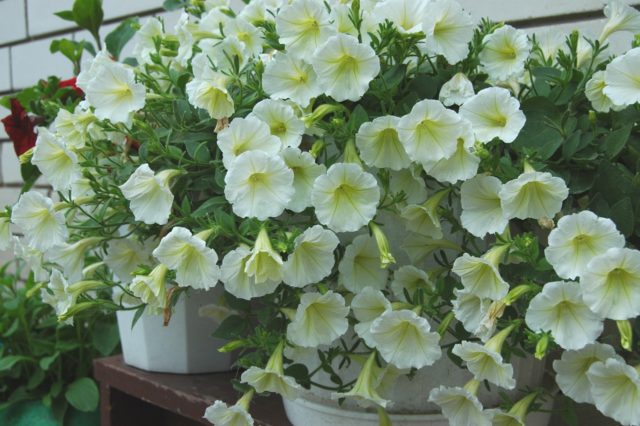
Minitunias are resistant to weather conditions and less demanding on feeding
The bright annual is actively used as a ground cover plant, placed in containers, pots, pots, and decorated with gazebos, balconies and city flower beds. Minitunia seeds are planted no earlier than mid-May, seedlings - in April, depending on climatic conditions. Like most varieties of petunias, this species does not tolerate direct sun, therefore, when sowing it, it is necessary to take into account the presence of shade. Watering should be moderate, however, the amount of moisture should be increased during the flowering period.
Mirabilis
This compact plant, not like a petunia, develops in the form of small-sized bushes up to 70-80 cm in height. Paired leaves of a dark green hue are ovoid, the color of the flowers is very diverse. In nature, mirabilis occurs in lilac, purple, raspberry, orange and bright yellow colors. Variegated and striped varieties are known.

Mirabilis blooms only at night
Night blooming is accompanied by a sweet pleasant aroma. By this quality, mirabilis is similar to another well-known plant - the night violet. For planting, you must select a well-lit area without drafts. Mirabilis is undemanding to the ground, prefers regular watering, but does not tolerate stagnant water.
Surfinia
Another petunia-like flowers are called surfiniya. This is a very beautiful culture, which during the flowering period is densely covered with bright large buds and outwardly resembles a ball. The average diameter of each flower is 5-6 cm.The color palette is very diverse: from milky white to purple, interspersed with dark purple. It grows up to 1.5-2 m.
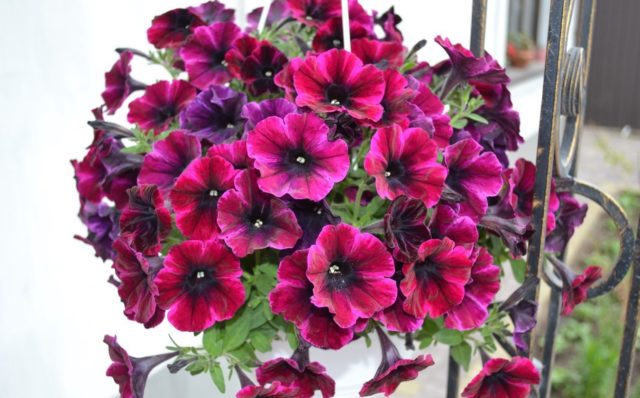
Surfinia has the longest flowering
Surfinia prefers good lighting, a temperature not lower than + 15 ° C, abundant, regular watering and a neutral soil composition. Top dressing of the hybrid is carried out in spring and autumn. During the summer season, shoots are pruned several times.
Morning glory
Ipomoea belongs to the Vyunkov family. It is attractive primarily for its bright colors, which are funnel-shaped and original color. The leaves resemble a heart. Garden morning glory can grow up to 5 m. It is surprising that the flowers of the culture not only bloom in the sun, but also turn after its movement. Bright "gramophone" closes at noon, however, if the day is cloudy, then it can happen in the late afternoon.
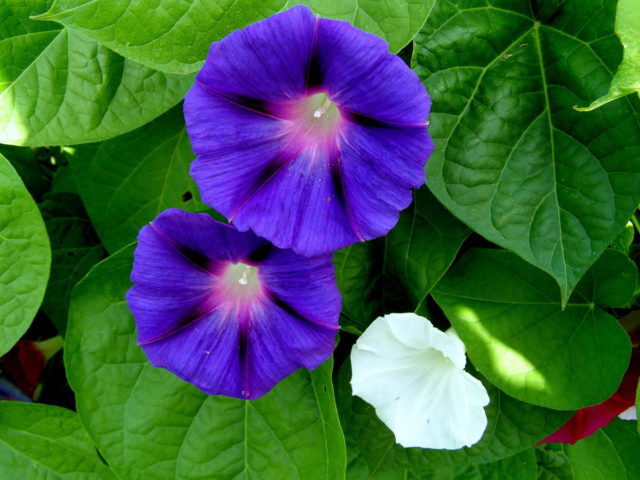
Morning glory is very beautiful, but poisonous
The plant blooms for a long time: from June to the first frost with red, blue, purple, white and pink flowers. She looks like a petunia in her unpretentiousness. Despite the fact that morning glory is a perennial, in the middle lane it is most often cultivated as an ampelous and ground cover annual.
Dope
Datura ordinary is a petunia-like plant with high poisonous properties. Botanists attribute it to the Solanaceae family. It is similar to petunia in unpretentiousness in terms of cultivation and care.
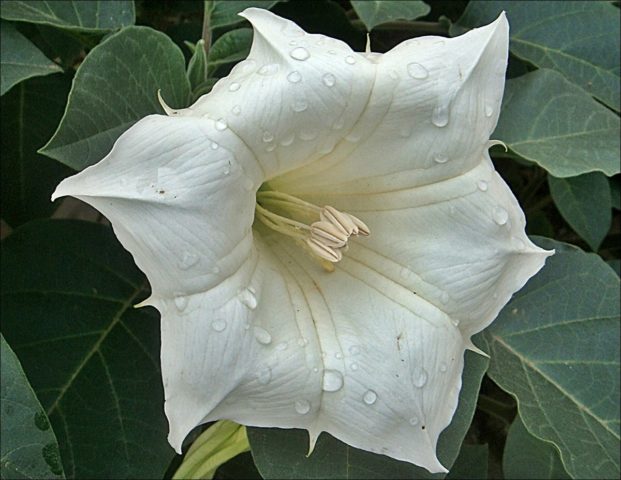
Datura requires careful handling and adherence to precautionary rules during the cultivation process
The culture has a powerful root system, a strong erect stem, reaches a height of 110-120 cm. The leaves are large, dark green, dull, slightly pointed. They have an unpleasant odor. Single white or purple Datura flowers are funnel-shaped and 10-12 mm in diameter. Bloom from early June to September. Also, like the leaves, they have an unpleasant odor. Reproduction takes place by seeds. The culture is sown in early spring.
Lavatera
Lavatera is an amazingly beautiful plant with large flowers that shine with a silky sheen. They are characterized by a palette of pink, purple, blue, yellow and white. The average diameter is 8-10 cm. Lavatera is a plant with a powerful root system, strong stems and a very spectacular crown. Bushes can grow up to 1-1.2 m in height.
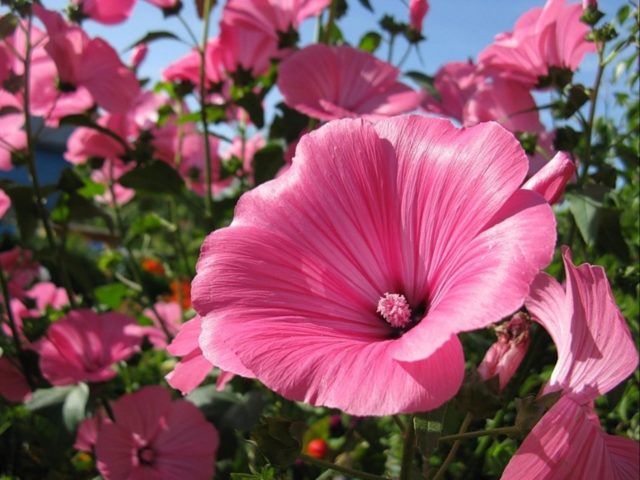
The second name of the lavatera is wild rose
This species blooms from June to October. Lavatera is very unpretentious to care for, so it is often called "a plant for the lazy." The variety is resistant to drought, withstands drafts, not picky about the composition of the soil. Flowers look great in cut and stand up to 6-7 days without fading.
Scented tobacco
The cultivation of scented tobacco (Nicotiana alata) began in 1867. This member of the Solanaceae family has erect shoots, large leaves and small flowers that resemble a star. Their color is very diverse. The flowers of scented tobacco can be white, crimson, scarlet, yellow or pink.

Fragrant tobacco dissolves in cloudy weather
The beginning of the flowering period of this species is June, the end of budding is September. The annual is classified as a thermophilic species and is sown mainly through seedlings. In addition to regular watering and loosening, it is necessary to remove faded flowers of scented tobacco in a timely manner.
Thunbergia
A plant such as tunbergia is represented in botany by both bushes and vines. The leaf plates are large, reaching a length of 3-10 cm, have soft pubescence and pronounced lobes. Flowers are similar to petunia, only smaller, do not exceed 3-4 cm in diameter. They can be single or make up whole inflorescences. Possess the richest color. In nurseries, you can find lilac, blue, yellow, orange, blue, white and brown tunbergia. Species with red inflorescences are extremely rare.
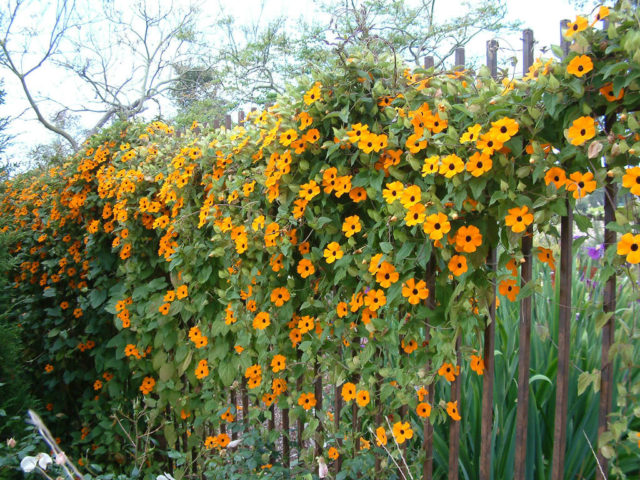
Only some varieties of tunbergia have a strong aroma, others practically do not smell
Blooms, this representative of the Akantovs from July to September.In the southern regions it is cultivated as a perennial, in the middle latitudes - as an annual. It looks like petunia in unpretentiousness. Under favorable conditions, it can grow up to 2 m.
Campsis
Another liana-like plant is Kampsis. The main difference is that its stem over time can cover the bark. In addition, Kampsis regularly sheds its foliage. Flowers of culture - funnel-shaped large up to 10 cm in length. The shade is predominantly orange.
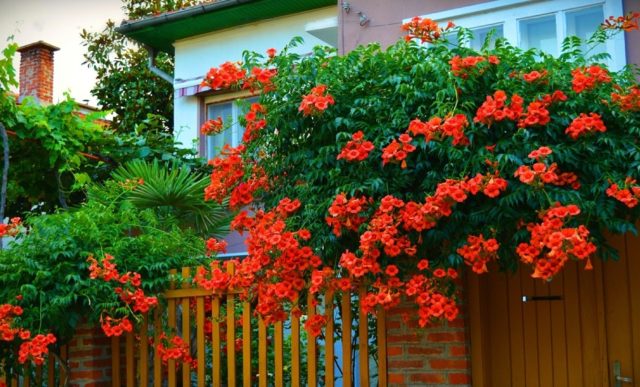
Liana Kampsis can reach a length of 15 m
For planting, he prefers southern, well-lit areas. Kampsis is similar to petunia with low requirements for the composition of the soil. Loves moderate watering and timely pruning.
Conclusion
Flowers similar to petunias are in great demand among both ordinary gardeners and landscape designers. They are widely used not only for garden decoration, but also for decorating open spaces, houses, cafes and restaurants.







